Finding Relief: How A Back Posture Corrector Can Help You Stand Taller Today
Feeling a persistent ache in your back, perhaps after a long day at your desk or just from going about your usual activities? You are certainly not alone in this experience. Back pain is a common medical problem, affecting a huge number of people, so it's almost a shared experience for many of us.
In fact, about 80% of adults experience pain in their back at some point in their lives, which is a rather significant number. This discomfort, whether it's a dull throb or a sharp sensation, can really get in the way of your daily life, making simple things feel like a big effort. Sometimes, improving how you hold your body can make a world of difference, and that's where a back posture corrector comes into the picture, helping you stand more upright.
This article will explore how a back posture corrector can offer support and guidance for your spine, helping you find a better way to hold yourself. We will look at why good posture matters, what causes some of our aches, and how these helpful devices can play a part in feeling better, you know, just generally more comfortable.
Table of Contents
- Why Your Posture Matters More Than You Think
- Understanding Back Discomfort: What's Going On?
- What Exactly is a Back Posture Corrector?
- Choosing the Right Back Posture Corrector for You
- Using Your Back Posture Corrector Effectively
- When to Talk to a Healthcare Provider
- Frequently Asked Questions About Posture Correctors
- Conclusion
Why Your Posture Matters More Than You Think
Holding your body well, or having good posture, is actually quite important for your overall health and how you feel each day. It's not just about looking good, though that is a nice benefit, you know. Good posture helps your body work as it should, allowing your muscles and bones to be in their proper places, which means less strain and discomfort, basically.
When you stand or sit correctly, your spine stays in its natural curves, distributing your weight evenly. This can prevent unnecessary stress on your joints and ligaments, which can often lead to aches and pains. A back posture corrector can gently guide your body into this better alignment, making it easier to maintain that good position throughout the day, so you feel better.
Over time, poor posture can contribute to many issues, not just back pain. It can affect your breathing, digestion, and even your mood. So, paying attention to how you hold yourself is a very worthwhile effort for your general well-being, really.
- Where To Watch Beautiful Disaster Movie Online
- Who Are Lilia Vu Parents
- Is Sierah Joughin Boyfriend Josh
Understanding Back Discomfort: What's Going On?
Before we talk more about how a back posture corrector can help, it's a good idea to understand why your back might be hurting in the first place. Many factors may cause different types of back pain, and knowing some of these can help you figure out what might be going on with your own body, you know.
Sometimes, it's just from sitting too long in a slumped position, or maybe lifting something heavy the wrong way. Other times, it could be something a bit more involved. Determining the cause can help you find relief and prevent future pain, which is pretty important for long-term comfort.
Common Causes of Back Pain
Our backs are quite complex structures, made up of bones, muscles, ligaments, and nerves, and any of these parts can cause trouble. Often, the pain comes from everyday habits that put stress on our spine. For example, spending hours hunched over a computer or phone is a common culprit these days, you know, leading to what some call "tech neck" or upper back strain.
Lifting heavy objects incorrectly, not getting enough movement, or even sleeping in an awkward position can also contribute to discomfort. Sometimes, it's simply a muscle strain from overuse or a sudden movement. Learning the parts of the back and what may be causing your back pain can give you a clearer picture of your situation, which is always helpful.
Age can also play a role, as our bodies change over time, and certain conditions might develop. However, many back issues are related to how we carry ourselves and the physical demands we place on our bodies, often without even realizing it, that's just how it goes sometimes.
Debunking Common Back Pain Myths
There are many ideas floating around about back pain, and some of them are not quite right. Are you feeling confused about back pain causes and the best remedies? We’ve debunked eight common back pain myths, which can help clear up some misunderstandings. For instance, some people believe that any back pain means you need surgery, but that's almost never the case for most everyday aches.
Another common idea is that you should rest completely when your back hurts. While some rest can be good, too much inactivity can actually make things worse, so movement is often encouraged. It's really about finding a balance and understanding what your body needs, you know.
Misconceptions can sometimes lead people to avoid activities that would actually help them, or to try remedies that aren't effective. Getting good information is pretty vital for managing your pain and feeling better, honestly.
What Exactly is a Back Posture Corrector?
A back posture corrector is a device designed to help you maintain better alignment of your spine and shoulders. Think of it as a gentle reminder or a sort of physical coach for your body. These devices typically use straps or supportive materials to pull your shoulders back and encourage your spine to straighten, so it's a bit like wearing a supportive vest.
They aren't meant to do all the work for you, but rather to help train your muscles to remember what good posture feels like. Over time, the idea is that your body will start to adopt these better habits naturally, even when you're not wearing the corrector, which is the main goal.
There are many different styles and designs available, each offering a slightly different approach to support. Some are quite subtle and can be worn under clothing, while others offer more robust support for specific activities, you know, depending on what you need.
How These Devices Offer Support
A back posture corrector works by providing physical feedback to your body. When you start to slouch, the corrector creates a gentle tension or pressure that makes you aware of your posture, prompting you to adjust. It’s like a little nudge to remind you to sit or stand tall, which can be really helpful when you're focused on other things.
They help to engage the muscles in your upper back and shoulders that might have become weak or stretched out from poor habits. By encouraging these muscles to work more, the corrector assists in strengthening them over time. This process of strengthening and reminding helps to correct bad posture patterns, making it easier to hold yourself well without the device, so that's the main benefit.
It's not a quick fix, but rather a tool to support your journey toward better posture. Consistency in using it, along with being mindful of your body, is what really brings about lasting change, honestly.
Different Kinds of Posture Support Devices
When you start looking, you'll find a few main types of back posture correctors, each with its own design and purpose. Some are like a harness that goes around your shoulders and upper back, gently pulling them back into alignment. These are often quite discreet and good for daily wear, you know, under your clothes.
Then there are full-back braces that offer more extensive support, covering a larger area of your back. These might be used for more significant posture issues or during specific activities where extra support is needed. There are also smart posture correctors that use sensors to detect when you're slouching and provide a gentle vibration as a reminder, which is pretty clever.
The best type for you really depends on your specific needs, the extent of your posture issues, and how you plan to use it. It's worth exploring the options to see what feels most comfortable and effective for your body, more or less.
Choosing the Right Back Posture Corrector for You
Picking the right back posture corrector can feel a bit overwhelming with all the choices out there, but it doesn't have to be. The key is to think about what you need it for and what will be comfortable enough for you to actually use regularly, you know. A corrector that sits in your closet won't help anyone.
Consider your daily routine: Will you be wearing it at work, during exercise, or just around the house? This will influence the type and design that works best. Also, think about the level of support you feel you need, as some offer a lighter touch while others provide more firm assistance, that's just how they are.
It's a bit like choosing a good pair of shoes; comfort and function are pretty important. Taking the time to research and perhaps even try a few different kinds can make a big difference in your experience, really.
Fit and Comfort Are Key
The most important thing about a back posture corrector is that it fits you well and feels comfortable when you wear it. If it's too tight, it can cause discomfort or restrict your movement, which defeats the purpose. If it's too loose, it won't provide the support you need, so it's almost useless.
Look for adjustable straps and breathable materials that won't irritate your skin. Many correctors come in different sizes, so make sure to check the sizing guide carefully before you buy. Remember, you'll likely be wearing this for periods of time, so comfort is absolutely essential for consistent use, honestly.
A well-fitting corrector should feel like a gentle embrace, guiding you rather than forcing you into position. It should not cause pain or numbness, and if it does, it's probably not the right fit for you, or you might need to adjust it, you know.
Material and How Long It Lasts
The materials used in a back posture corrector affect both its comfort and how long it will last. You want something that is durable enough to withstand regular use but also soft against your skin. Neoprene, nylon, and various breathable mesh fabrics are commonly used, so you have options.
Think about how easy it is to clean, especially if you plan to wear it often or during activities that might make you sweat. A corrector that can be hand-washed or easily wiped down is pretty convenient. Good stitching and strong fasteners also indicate a well-made product that will hold up over time, that's just common sense.
Investing in a corrector made from good materials can mean it lasts longer and provides more consistent support, which is pretty good value, in a way.
Thinking About Your Daily Habits
Your lifestyle plays a big role in deciding which back posture corrector is right for you. If you spend many hours sitting at a desk, a discreet upper-back corrector might be ideal for gentle reminders throughout the workday. For those who are more active, perhaps a less restrictive design that allows for a full range of motion would be better, you know, for movement.
If you're looking for something to wear during workouts or while doing chores around the house, a more robust design might offer the extra support you need. Consider how visible you want the corrector to be; some are designed to be worn under clothes without anyone knowing, which is often a preference for many.
Matching the corrector to your daily activities and preferences will make it much more likely that you'll use it consistently, which is the key to seeing results, honestly.
Using Your Back Posture Corrector Effectively
Getting a back posture corrector is just the first step; using it correctly and consistently is what really brings about change. It's not a magic solution on its own, but rather a tool to help you build better habits. Think of it as a guide, helping your body learn what proper alignment feels like, you know.
The goal is to gradually strengthen your own muscles so that you can maintain good posture even without the corrector. This means combining its use with other positive habits like gentle exercises and being mindful of how you hold yourself throughout the day, that's pretty important.
Patience and consistency are pretty vital here. You won't see results overnight, but with regular effort, you can make significant improvements to your posture and overall comfort, really.
Starting Slowly is Best
When you first start using a back posture corrector, it's usually best to introduce it gradually. Don't try to wear it all day right away. Begin with short periods, perhaps 15-30 minutes at a time, and then slowly increase the duration as your body gets used to it, you know, building up tolerance.
This allows your muscles to adjust and prevents any discomfort from overcorrection. Your body needs time to adapt to the new alignment, and rushing it can lead to soreness or even discourage you from using it. Listen to your body and adjust the wearing time as needed, that's always a good idea.
Over time, you might find you can wear it for several hours, or you might only need it for specific activities where you tend to slouch, like working at your computer. It's about finding what works best for you, more or less.
Pairing with Other Good Habits
For the best results, use your back posture corrector as part of a broader approach to improving your posture and relieving back pain. This includes being aware of your posture throughout the day, whether you're sitting, standing, or walking. Simple things like adjusting your chair or screen height can make a big difference, you know.
Regular physical activity, especially exercises that strengthen your core and back muscles, is also incredibly helpful. Get tips to manage your pain, and know when to see your healthcare provider for more personalized advice. Hydration and a balanced diet also support overall spinal health, so it's a whole-body effort, really.
Think of the corrector as one tool in your toolkit for better posture and less pain, working alongside other healthy habits to give you the best chance at feeling good, honestly.
Simple Exercises for Your Back
Complementing your back posture corrector with gentle exercises can greatly enhance its effectiveness. These movements help to strengthen the muscles that support your spine and improve your flexibility. One simple exercise you can try is the "wall slide."
To do this, stand with your back flat against a wall, making sure your head, shoulders, and hips touch the surface. Place your feet about shoulder-width apart, a little bit away from the wall. Slowly lower as far as you can while maintaining your back flat against the wall, sliding down as if you're sitting in an imaginary chair. Hold for a few seconds, then slowly return to starting position while maintaining your back flat against the wall. This helps strengthen your back and leg muscles, which is pretty good for overall support.
Another simple one is shoulder blade squeezes: just gently pull your shoulder blades together as if you're trying to hold a pencil between them. Hold for a few seconds and release. Doing these regularly can really help improve your body's natural ability to hold good posture, you know.
When to Talk to a Healthcare Provider
While a back posture corrector can be a helpful tool for many, it's important to know when your back pain might need a doctor's attention. Many factors may cause different types of back pain, and sometimes, it's more than just poor posture. If your pain is severe, doesn't improve with self-care, or comes with other symptoms like numbness or weakness, it's definitely time to see a healthcare professional, that's just sensible.
Diagnosis of back pain: doctors use various tools to help diagnose the possible cause for your back pain, which helps determine the best treatment plan. They might ask about your medical and family history, and perform a physical exam. This helps them understand what's going on and guide you to the right solutions, you know.
A back posture corrector should be seen as a supportive aid, not a replacement for professional medical advice, especially for persistent or worsening pain. Always consult a doctor if you have concerns about your back health, that's pretty important for your well-being.

8 Best Back Exercises for Strength, Mass, and More

Illustration of back bones in human skeleton on white background

The Anatomy of Your Back Muscles, Explained (and How to Train Them